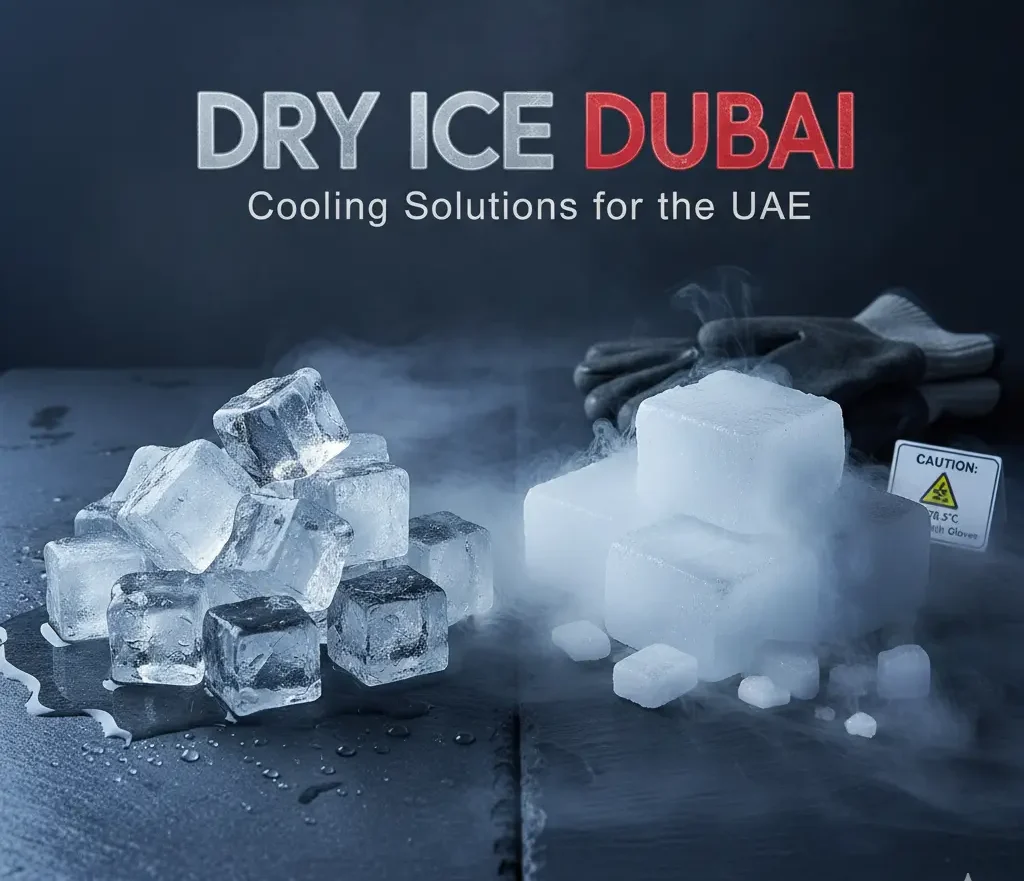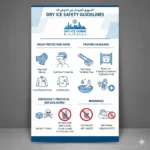When you hear “ice,” your mind likely pictures those familiar frozen water cubes chilling your drink. But there’s another fascinating form of ice that behaves very differently and serves a multitude of specialized purposes: dry ice. While both keep things cold, they are far from the same. Understanding their fundamental distinctions is crucial, especially if you’re looking for advanced cooling, preservation, or special effects solutions in the UAE. Dry Ice Dubai, your trusted dry ice supplier, is here to demystify these two icy counterparts.
What is Ordinary Ice (Water Ice)?
Ordinary ice is simply frozen water (H₂O). It forms at 0°C (32°F) and melts back into liquid water when its temperature rises above this point. You find it in your freezer, in ice chests, and in nature as snow or glaciers. Its primary function is to cool by absorbing heat as it melts, but this process leaves behind liquid residue, which can be messy and inconvenient for certain applications.
What is Dry Ice (Solid Carbon Dioxide)?
Dry ice, on the other hand, is the solid form of carbon dioxide (CO₂). It’s called “dry” because it doesn’t melt into a liquid; instead, it undergoes a process called sublimation, transforming directly from a solid into a gas. This unique property makes it an incredibly powerful and versatile cooling agent, reaching temperatures as low as -78.5°C (-109.3°F). At Dry Ice Dubai, we supply premium-grade dry ice in various forms, including blocks, pellets, and slices, catering to diverse industrial, medical, and entertainment needs across Dubai and the broader UAE.
Key Differences Between Dry Ice and Ordinary Ice
Let’s break down the essential distinctions that set these two forms of “ice” apart:
1. Composition: What Are They Made Of?
- Ordinary Ice: Primarily composed of water molecules (H₂O).
- Dry Ice: Primarily composed of carbon dioxide molecules (CO₂). This fundamental difference gives them their distinct physical and chemical properties.
2. Temperature: How Cold Do They Get?
- Ordinary Ice: Freezes and melts at 0°C (32°F).
- Dry Ice: Sublimes at a much colder -78.5°C (-109.3°F). This extreme cold makes it an indispensable agent for deep freezing and maintaining ultra-low temperatures where water ice simply isn’t sufficient or practical.
3. State Change: Melting vs. Sublimation
- Ordinary Ice: Undergoes melting, transitioning from a solid to a liquid. This process leaves behind water, which can damage goods, create a mess, or dilute products.
- Dry Ice: Undergoes sublimation, transitioning directly from solid to gas. This means no liquid residue is left behind, making it a “dry” cooling solution, perfect for sensitive goods, electronics, or applications where moisture is undesirable.
4. Cooling Power & Duration
- Ordinary Ice: Provides moderate cooling as it melts, but its cooling capacity is limited by its melting point. It typically doesn’t last as long, especially in warmer conditions.
- Dry Ice: Offers significantly more intense and prolonged cooling due to its much lower temperature and the substantial energy absorbed during sublimation. It can keep items frozen for much longer periods, making it ideal for extended transport or storage.
5. Applications: Where Are They Used?
Ordinary Ice: Primarily used for chilling beverages, cooling food in coolers for short periods, and basic medical cold packs.
Dry Ice: Used for a wide array of specialized applications due to its unique properties:
- Food Preservation & Logistics: Transporting frozen foods, preserving seafood, ice cream, and catering. Our Dry Ice Blocks provide prolonged cooling for these needs.
- Medical & Pharmaceutical: Shipping vaccines, organs, blood samples, and other biological materials. Dry Ice Dubai offers certified medical-grade dry ice crucial for cold chain integrity.
- Industrial Cleaning: Dry ice blasting to efficiently remove dirt, grease, paint, and contaminants from sensitive equipment and machinery without water or chemicals.
- Special Effects: Creating dense, low-lying fog and dramatic smoke effects for weddings, concerts, film sets, and events.
- Pest Control: Safely and effectively eliminating rodents in burrows.
6. Safety & Handling: Key Precautions
- Ordinary Ice: Generally safe to handle with bare hands.
- Dry Ice: Requires extreme caution. Its ultra-low temperature can cause severe frostbite upon direct skin contact, so always handle it with insulated gloves. Also, as it sublimes, it releases CO₂ gas. In poorly ventilated areas, this gas can displace oxygen, posing an asphyxiation risk. Always use and store dry ice in well-ventilated spaces.
7. Storage:
- Ordinary Ice: Can be stored in regular freezers or insulated coolers.
- Dry Ice: Must be stored in a well-insulated container (like a high-quality cooler) that is not airtight. An airtight container could explode as the sublimating CO₂ builds up pressure. It should never be stored in a regular freezer as most are not cold enough to effectively slow sublimation, causing it to disappear quickly.
Why This Distinction Matters for You in the UAE
For businesses and individuals in Dubai and across the UAE, choosing the right type of ice is paramount for efficiency, safety, and effectiveness. If your requirements involve robust, residue-free cooling for critical logistics, sensitive medical samples, industrial cleaning, or captivating event effects, dry ice is the superior and often essential choice. Dry Ice Dubai provides certified food and medical-grade dry ice, offering unparalleled reliability, safety, and efficient same-day delivery services to ensure your specific needs are met with precision.
Frequently Asked Questions (FAQs) About Dry Ice and Ordinary Ice
Is dry ice dangerous?
Yes, dry ice is dangerous if not handled properly. Its extremely low temperature (-78.5°C) can cause severe frostbite upon direct skin contact, so always use thick, insulated gloves. Additionally, it releases carbon dioxide gas as it sublimes, which can lead to asphyxiation in enclosed, poorly ventilated spaces. Always ensure adequate ventilation when using or storing dry ice.
Can I store dry ice in my home freezer?
No, you should not store dry ice in an airtight home freezer. Dry ice will continuously sublime, releasing CO₂ gas. If the freezer is airtight, this pressure can build up and cause an explosion. A regular freezer also isn’t cold enough to prevent rapid sublimation, meaning your dry ice will disappear quickly. Store it in a well-insulated, non-airtight container, like a heavy-duty cooler, in a well-ventilated area.
How long does dry ice last?
The lifespan of dry ice depends on several factors: its size and form (larger blocks generally last longer than pellets or slices), the quality of insulation in the container, and the ambient temperature. Generally, dry ice sublimes at a rate of 5-10 pounds (approx. 2.2-4.5 kg) per 24 hours in a typical insulated cooler. Better insulation significantly extends its duration.
Where can I buy dry ice in Dubai?
You can purchase high-quality dry ice in various forms (blocks, pellets, slices) from Dry Ice Dubai. We offer reliable supply, certified food and medical-grade products, and same-day delivery services across Dubai and next-day delivery throughout the UAE. Visit our products page or contact us directly to place your order.
Can dry ice be used to keep food cold during power outages?
Yes, dry ice is an excellent solution for keeping food cold or frozen during power outages. Place it on top of items in your freezer or cooler (as cold CO₂ gas sinks). Remember to use insulated gloves, ensure proper ventilation, and avoid direct contact with unwrapped food items, as it can cause freezer burn.
What is the fog created by dry ice?
The fog produced by dry ice is not smoke, but rather condensed water vapor. When dry ice (solid CO₂) comes into contact with warm water or moist air, it rapidly sublimes. The extremely cold CO₂ gas then chills the surrounding air, causing the moisture in the air to condense into a visible, dense, low-lying fog, perfect for special effects.






